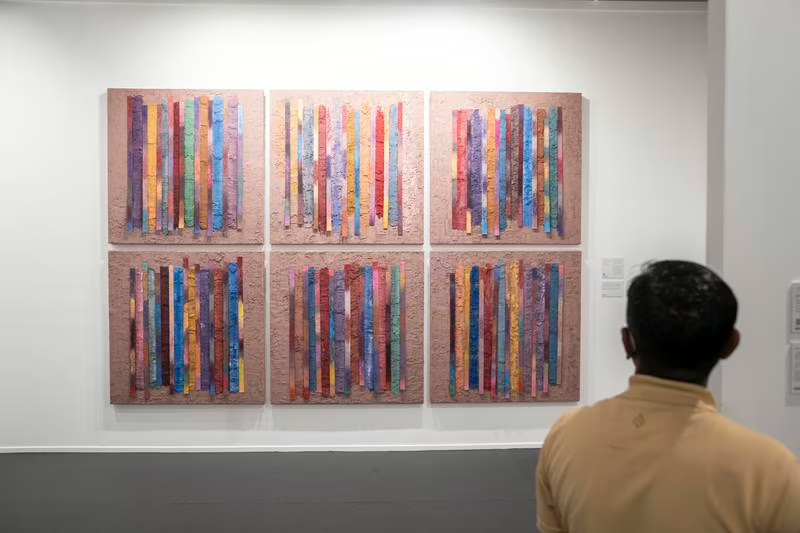Maan Jalal
The post-pandemic world has been an unpredictable place for art fairs. While some established international events have been cancelled due to rising costs and dwindling dealer interst, such as London’s annual Masterpiece fair run by Art Basel’s parent company MCH Group, others, such as Singapore’s long-awaited Art SG have emerged, sensing new opportunities.
Unique among the crowded cultural landscape is Art Dubai, which was the first art fair to return to physical events, and has continued to go from strength to strength. As the fair prepares for its 16th event, which runs from Wednesday until Sunday, its executive director, Benedetta Ghione, tells The National there are various reasons why it has remained so successful.
“The art fairs that will make it are the ones that will have a strong ‘why’ and a point of difference of one kind or another,” Ghione says.
She adds that the expectation for art practitioners and enthusiasts to attend every art fair during cultural season has changed since the pandemic and visitors are starting to be more strategic about which they attend. While this shift of perspective has left some art fairs struggling, Art Dubai has stood to benefit.
Ghione believes that the cosmopolitan, forward-thinking nature of Dubai itself is a crucial reason why the fair continues to flourish. The city’s identity as a diverse cultural hub is reflected in the content at the event, which feels natural to the region and out of context in fairs such as Art Basel — which has long struggled with a lack of representation.
“Dubai handled the pandemic beautifully and really took the opportunity to bring itself to the next stage as a global hub,” Ghione says. “And therefore, our proposition of trying to position Dubai as a global cultural hub is enabled and facilitated by the context of Dubai.”
The art world is seeing an exponential change on many fronts. Art is becoming increasingly cross-cultural, with boundaries between communities and spaces constantly collapsing, while the demographics of those collecting art continues to evolve.
One of the growing sections in Art Dubai is South Asian art, which Ghione explains is part of the fair’s aim to become the foremost platform for showcasing works from the global south.
“At a time when non-western, non-male, non-white, narratives are becoming more prevalent, our proposition is really strong.
“This is not for us a curated section that may feel tokenistic, as it might at another fair. It’s 95 per cent of what we’ve always done. We’ve never really been the fair for the mainstream, big, western galleries to come and display and sell work. That was never our identity.”
Since Art Dubai’s inception, the fair has had an extensive non-commercial programme, ranging from artist residences to prizes, with a focus on emerging and established artists from the region.
“We’re aligned to our time more by being who we are than for any other reason,” Ghione says.
“Things that are now becoming really relevant because they are sustainable, meaningful, feel ingrained and make sense in their communities, and don’t feel parachuted, have always been part of our DNA.”
:quality(70)/cloudfront-eu-central-1.images.arcpublishing.com/thenational/L5RJ3MYIQ5GBTZJDTKDWQUWKVQ.jpg)
Art Dubai started as a fair with a strong Middle Eastern focus. Today however, it has expanded to a point where visitors are exposed to works from contemporary and classic art spanning from Nigeria to the Philippines.
This expanding diversity of work has become a strong thread in the expected tapestry that constitutes Art Dubai’s DNA.
Aside from this cultural expansion, Art Dubai is also becoming a platform for a growing sector of works that live beyond the physical world — digital art. Last year, it became the first fair to have a section dedicated to such pieces.
The festival’s aim, Ghione says, was not to follow the hype of digital art, by for example focusing superficially on NFTs, but to open the dialogue on what digital art is and how it’s shaping the art world.
“Dubai is the city of the future, making a play as a global crypto hub, and so it makes a lot of sense that potentially a dedicated digital section would be in our fair,” she says.
“We believe that digital art is here to stay beyond the ups and downs of the market. We feel strongly that the way new media artists are creating work is going to change the landscape, not just for artists who are interested in new media, but for those creating art through traditional practices.”
Ghione says the fair aims to remain malleable enough to move with the changing arts landscape while retaining its broader perspective, through a flexible approach to operations.
“We are used to being fluid, it’s always been written into the DNA of the fair. We also take our cues from the city of Dubai, which is so steeped in a spirit of innovation,” she says.
It’s important, Ghione adds, to focus on the overall vision of the fair and where it sits not only within the region, but the greater framework of the art world.
“We really want to be that catalyst, and the pillars that help the growth of Dubai,” she says.
“Then the ‘how’ of how that manifests can stay more fluid. We are always welcoming of experimentation because some of our best programmes and ideas were born from it.”
Courtesy: thenationalnews







